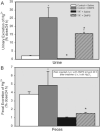Multidrug resistance proteins and the renal elimination of inorganic mercury mediated by 2,3-dimercaptopropane-1-sulfonic acid and meso-2,3-dimercaptosuccinic acid
- PMID: 17940195
- PMCID: PMC2409288
- DOI: 10.1124/jpet.107.130708
Multidrug resistance proteins and the renal elimination of inorganic mercury mediated by 2,3-dimercaptopropane-1-sulfonic acid and meso-2,3-dimercaptosuccinic acid
Abstract
Current therapies for inorganic mercury (Hg(2+)) intoxication include administration of a metal chelator, either 2,3-dimercaptopropane-1-sulfonic acid (DMPS) or meso-2,3-dimercaptosuccinic acid (DMSA). After exposure to either chelator, Hg(2+) is rapidly eliminated from the kidneys and excreted in the urine, presumably as an S-conjugate of DMPS or DMSA. The multidrug resistance protein 2 (Mrp2) has been implicated in this process. We hypothesize that Mrp2 mediates the secretion of DMPS- or DMSA-S-conjugates of Hg(2+) from proximal tubular cells. To test this hypothesis, the disposition of Hg(2+) was examined in control and Mrp2-deficient TR(-) rats. Rats were injected i.v. with 0.5 mumol/kg HgCl(2) containing (203)Hg(2+). Twenty-four and 28 h later, rats were injected with saline, DMPS, or DMSA. Tissues were harvested 48 h after HgCl(2) exposure. The renal and hepatic burden of Hg(2+) in the saline-injected TR(-) rats was greater than that of controls. In contrast, the amount of Hg(2+) excreted in urine and feces of TR(-) rats was less than that of controls. DMPS, but not DMSA, significantly reduced the renal and hepatic content of Hg(2+) in both groups of rats, with the greatest reduction in controls. A significant increase in urinary and fecal excretion of Hg(2+), which was greater in the controls, was also observed following DMPS treatment. Experiments utilizing inside-out membrane vesicles expressing MRP2 support these observations by demonstrating that DMPS- and DMSA-S-conjugates of Hg(2+) are transportable substrates of MRP2. Collectively, these data support a role for Mrp2 in the DMPS- and DMSA-mediated elimination of Hg(2+) from the kidney.
Figures









References
-
- Aposhian HV. DMSA and DMPS: water soluble antidotes for heavy metal poisoning. Ann Rev Pharmacol Toxicol. 1983;23:193–215. - PubMed
-
- Aposhian HV, Aposhian MM. Meso-2,3-dimercaptosuccinic acid: chemical, pharmacological, and toxicological properties of an orally effective metal chelating agent. Annu Rev Pharmacol Toxicol. 1990;30:279–306. - PubMed
-
- Aposhian HV, Maiorino RM, Rivera M, Bruce DC, Dart RC, Hurlbut KM, Levine DJ, Zheng W, Fernando Q, Carter D, et al. Human studies with the chelating agents DMPS and DMSA. Clin Toxicol. 1992;30:505–528. - PubMed
-
- Aposhian HV, Maiorino RM, Gonzalez-Ramirez D, Zuniga-Charles M, Xu Z, Hurlbut KM, Junco-Munoz P, Dart RC, Aposhian MM. Mobilization of heavy metals by newer, therapeutically useful chelating agents. Toxicology. 1995;97:23–38. - PubMed
-
- Bahn A, Knabe M, Hagos Y, Rodiger M, Godehardt S, Graber-Neufeld DS, Evans KK, Burckhardt G, Wright SH. Interaction of the metal chelator 2,3-dimercapto-1-propoanesulfonate with the rabbit multispecific organic anion transporter 1 (rbOAT1). Mol Pharmacol. 2002;62:1128–1136. - PubMed
Publication types
MeSH terms
Substances
Grants and funding
LinkOut - more resources
Full Text Sources
Medical

